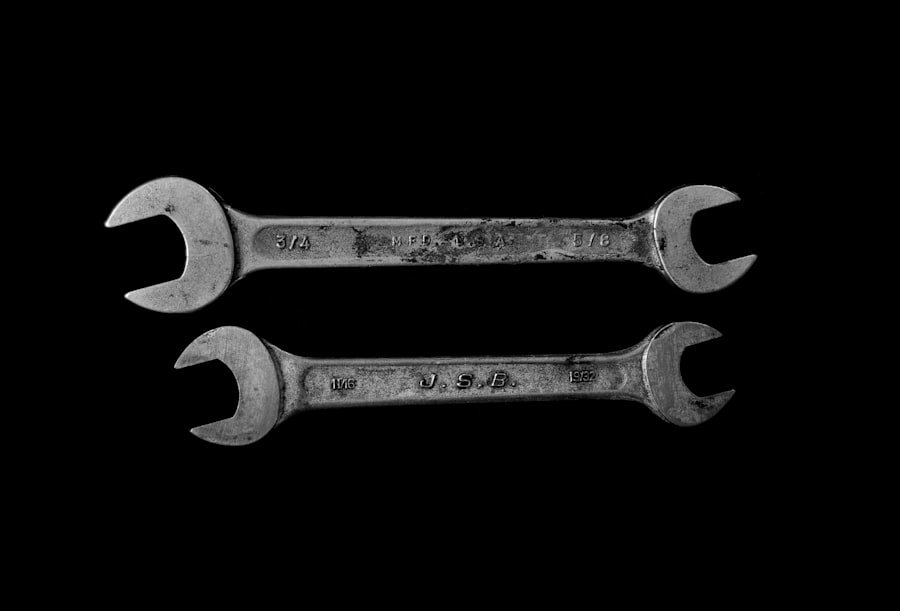A ratchet tool is a versatile hand tool used for tightening or loosening nuts and bolts. It comprises a handle, a ratcheting mechanism, and a socket that fits over the nut or bolt. The ratcheting mechanism allows the user to turn the handle in one direction while the socket remains stationary, then quickly switch to turning the handle in the opposite direction without removing the socket from the fastener.
This design makes the ratchet tool particularly effective in confined spaces where traditional wrenches may be impractical. Ratchet tools are available in various sizes, with the most common drive sizes being 1/4-inch, 3/8-inch, and 1/2-inch. The drive size refers to the dimensions of the square end of the ratchet to which the socket attaches.
Larger drive sizes can handle greater torque. These tools also feature different handle types, including fixed, flex, and extendable options, as well as various ratcheting mechanisms such as quick-release and fine-tooth designs. Understanding the fundamental components and variations of ratchet tools is crucial for selecting the appropriate tool for specific DIY projects.
This knowledge enables users to choose the most suitable ratchet tool based on the task requirements, workspace constraints, and desired level of precision.
Key Takeaways
- The ratchet tool is a versatile hand tool used for tightening or loosening nuts and bolts.
- Consider the size, drive, and socket type when choosing the right ratchet tool for your DIY project.
- To master the art of using the ratchet tool, practice using it in different positions and angles.
- Always wear safety goggles and gloves when using the ratchet tool to prevent injuries.
- Avoid over-tightening or using the wrong size socket when using the ratchet tool to prevent damage to the tool and the fastener.
Choosing the Right Ratchet Tool for Your DIY Project
Size and Type of Nuts and Bolts
The size and type of nuts and bolts you’ll be working with play a significant role in choosing the right ratchet tool. For smaller nuts and bolts, a 1/4-inch drive ratchet tool may be sufficient, while larger ones may require a 3/8-inch or 1/2-inch drive ratchet tool.
Ratcheting Mechanism and Handle Type
The type of ratcheting mechanism and handle type are also important considerations. A quick-release ratchet allows for easy socket changes, while a fine-tooth ratchet provides a smoother and more precise operation. If you’ll be working in tight spaces, a ratchet tool with a flex or extendable handle may be more suitable than one with a fixed handle.
Quality and Performance
The quality of the ratchet tool is also a critical factor. A high-quality tool will be more durable and provide better performance than a lower-quality tool. By taking the time to choose the right ratchet tool, you’ll ensure that you have the right tool for the job and can complete your project efficiently and effectively.
Mastering the Art of Using the Ratchet Tool

Using a ratchet tool may seem straightforward, but mastering the art of using it effectively requires some practice and technique. When using a ratchet tool, it is important to ensure that the socket is securely attached to the nut or bolt to prevent slipping or stripping. Additionally, it is important to use the correct size socket for the nut or bolt to avoid damaging the fastener or the socket.
When using a ratchet tool, it is important to apply steady pressure while turning the handle to avoid over-tightening or stripping the nut or bolt. It is also important to use the correct direction of rotation, as ratchet tools are designed to tighten in one direction and loosen in the opposite direction. Finally, it is important to use the appropriate amount of torque for the nut or bolt being tightened or loosened, as over-tightening can cause damage and under-tightening can result in loose fasteners.
Mastering the art of using a ratchet tool requires attention to detail and practice, but with time and experience, you can become proficient in using this versatile hand tool for a wide range of DIY projects.
Safety Tips for Using the Ratchet Tool
| Tip Number | Safety Tip |
|---|---|
| 1 | Always wear safety goggles to protect your eyes from flying debris. |
| 2 | Inspect the ratchet tool for any damage or wear before use. |
| 3 | Use the correct size socket for the ratchet tool to avoid slippage. |
| 4 | Keep your hands and fingers away from the ratchet mechanism while in use. |
| 5 | Store the ratchet tool in a safe place to prevent accidents or damage. |
While ratchet tools are relatively safe to use when used properly, there are some safety tips to keep in mind when using them for DIY projects. First and foremost, it is important to wear appropriate personal protective equipment, such as gloves and safety glasses, to protect yourself from potential hazards such as sharp edges or flying debris. When using a ratchet tool, it is important to ensure that the work area is well-lit and free from clutter to avoid tripping hazards or accidental damage to surrounding objects.
It is also important to use the correct size socket for the nut or bolt being worked on to prevent slipping or stripping. Additionally, it is important to use the correct amount of torque when tightening or loosening nuts and bolts to avoid damage to fasteners or tools. Finally, it is important to store ratchet tools properly when not in use to prevent damage and ensure that they are in good working condition for future use.
Following these safety tips will help ensure that you can use your ratchet tool safely and effectively for your DIY projects.
Common Mistakes to Avoid When Using the Ratchet Tool
While using a ratchet tool may seem straightforward, there are some common mistakes that should be avoided to ensure safe and effective use. One common mistake is using an incorrect size socket for the nut or bolt being worked on, which can lead to slipping or stripping of the fastener. Another common mistake is using excessive force when tightening or loosening nuts and bolts, which can lead to over-tightening or damage to fasteners.
It is also important to avoid using a damaged or worn ratchet tool, as this can compromise its performance and safety. Additionally, it is important to avoid using a ratchet tool in wet or slippery conditions, as this can increase the risk of accidents and injuries. Finally, it is important to avoid using a ratchet tool with an extension bar that is too long, as this can reduce its torque capacity and compromise its effectiveness.
By being aware of these common mistakes and taking steps to avoid them, you can ensure that you are using your ratchet tool safely and effectively for your DIY projects.
Advanced Techniques for Using the Ratchet Tool

Working in Tight Spaces
Once you have mastered the basics of using a ratchet tool, you can take your skills to the next level by using a swivel head ratchet for working in tight spaces or at awkward angles. This allows for greater flexibility and maneuverability, making it easier to access hard-to-reach areas.
Precise Torque Application
Another advanced technique is using a torque wrench attachment with your ratchet tool to ensure precise torque application when tightening fasteners. This is especially important when working with sensitive or critical components that require specific torque settings.
Expanding Versatility and Functionality
Using a ratchet tool with an extendable handle can provide greater leverage for loosening stubborn nuts and bolts. Additionally, learning how to use different types of sockets and accessories, such as universal joints and extension bars, can expand the versatility and functionality of your ratchet tool. This enables you to tackle a wider range of DIY projects and tasks with confidence.
By learning and practicing these advanced techniques, you can become more proficient in using your ratchet tool and take your DIY skills to new heights.
Tips for Maintaining and Caring for Your Ratchet Tool
Proper maintenance and care are essential for ensuring that your ratchet tool remains in good working condition and provides reliable performance for years to come. One important tip for maintaining your ratchet tool is keeping it clean and free from dirt, debris, and moisture that can cause corrosion or damage. It is also important to regularly inspect your ratchet tool for any signs of wear or damage and replace any worn or damaged parts as needed.
Additionally, it is important to store your ratchet tools in a dry and secure location when not in use to prevent damage and ensure that they are ready for use when needed. It is also important to lubricate the moving parts of your ratchet tools regularly to ensure smooth operation and prevent premature wear. Finally, it is important to follow any manufacturer’s recommendations for maintenance and care specific to your ratchet tool model.
By following these tips for maintaining and caring for your ratchet tools, you can ensure that they remain in good working condition and provide reliable performance for all your DIY projects.
If you’re interested in learning more about the latest tools and equipment, you might want to check out this article on Mahindra revving up for a new era of mobility. It discusses the advancements in technology and innovation in the automotive industry, which could potentially impact the development of tools like ratchets.
FAQs
What is a ratchet tool?
A ratchet tool is a type of mechanical device that allows for continuous linear or rotary motion in only one direction while preventing motion in the opposite direction.
How does a ratchet tool work?
A ratchet tool works by using a gear and pawl mechanism to allow for motion in one direction while preventing motion in the opposite direction. When the tool is turned in the desired direction, the pawl engages with the gear teeth, allowing for smooth and continuous motion.
What are the common uses of a ratchet tool?
Ratchet tools are commonly used in automotive repair, construction, and mechanical engineering. They are often used for tightening or loosening bolts and nuts in hard-to-reach areas.
What are the different types of ratchet tools?
There are several types of ratchet tools, including socket wrenches, torque wrenches, and adjustable ratchet handles. Each type is designed for specific applications and may have different features and capabilities.
What are the benefits of using a ratchet tool?
Ratchet tools provide increased efficiency and ease of use when working with fasteners. They allow for quick and precise tightening or loosening of bolts and nuts, especially in tight or confined spaces.




















+ There are no comments
Add yours